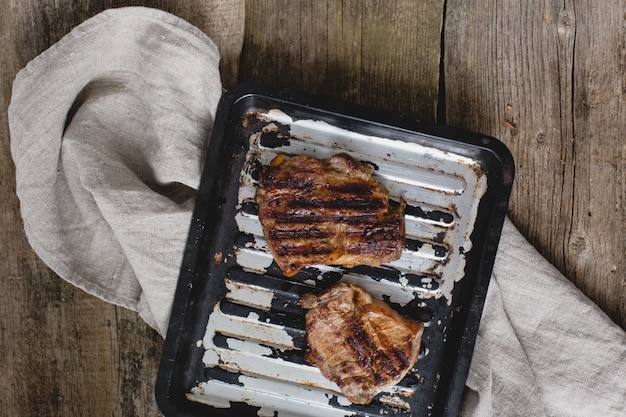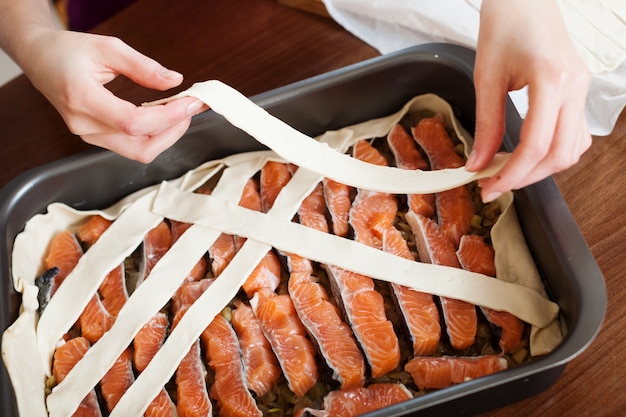(Part 1) The Cast Iron Advantage: Why It's King of the Kitchen

The Ultimate Searing Power: Kiss Goodbye to Bland Steaks
Cast iron is a heat-loving beast. It can reach insanely high temperatures, which is what gives you that incredible, crispy crust on your steak. That sear isn't just about looks. It's like a delicious armor, locking in all those tasty juices and creating a flavor explosion.Heat Retention for Even Cooking: Goodbye Cold Spots, Hello Perfect Steak
Once your cast iron is hot, it holds that heat like a champion. This is crucial for even cooking. You don’t want one side burning while the other is still raw, right? Cast iron ensures that your steak cooks evenly, from edge to center, creating a consistently delicious texture.The Cast Iron Legacy: A Kitchen Staple for Generations
Cast iron isn't just a pan; it's a culinary heirloom. These pans are practically indestructible, built to last a lifetime (or several!). You're investing in something that will be around for generations to come, a piece of kitchen history that just keeps getting better with age.(Part 2) The Doneness Dilemma: How to Get It Just Right

The steak doneness chart: Your Guide to Steak Success
| Doneness | internal temperature (°F) | Internal Temperature (°C) | Description |
|---|---|---|---|
| Rare | 125-130 | 52-54 | Cool red center, warm edges |
| Medium Rare | 130-135 | 54-57 | Slightly pink center, warm throughout |
| Medium | 135-140 | 57-60 | Pink center, warm throughout |
| Medium Well | 140-145 | 60-63 | Slightly pink center, warm throughout |
| Well Done | 145 | 63 | No pink, cooked throughout |
Beyond the Thermometer: The Touch Test for Steak Savvy
While a meat thermometer is a great tool for precise doneness, I've been using a tried-and-true method for years: the finger test. Here’s how it works: Touch the fleshy part of your palm: This is roughly the temperature of a rare steak. Touch the tip of your thumb: This is similar to a medium-rare steak. Touch the base of your thumb: This is close to a medium steak. This isn't foolproof, but it's a great backup for those times when you don’t have a thermometer handy.(Part 3) The Cast Iron Steak Prep: Setting the Stage for Success

choosing the right cut: The Foundation of a Great Steak
Not all cuts of steak are created equal. For the best results, choose a cut that’s got good marbling, like ribeye, new york strip, or a good quality sirloin. This marbling adds flavor and ensures a juicy, tender steak.Bring It to Room Temperature: The Secret to Even Cooking
Many people skip this crucial step, but trust me, it makes a difference. Bringing your steak to room temperature before cooking helps it cook more evenly. It prevents that frustrating situation where the outside is charred, but the inside is still icy cold.Pat It Dry: The Key to a perfect sear
A dry steak is a happy steak. Pat your steak dry with paper towels before seasoning. This removes excess moisture, which helps create a beautiful sear and prevents steam from building up during cooking, which can inhibit browning.Seasoning It Up: Simple is Best
Salt is your best friend here. Season your steak liberally with salt and pepper on both sides. Don’t go overboard with spices. Let the natural flavor of the steak shine through.(Part 4) The Searing Ritual: A Cast Iron Masterclass
Now comes the fun part, the heart of cast iron steak cooking: the sear. This is where your pan takes center stage.Preheating Your Weapon: Getting the Cast Iron Smoking Hot
Get that cast iron screaming hot! Heat it over medium-high heat for 5-7 minutes, or until a water droplet sizzles and evaporates immediately. You want that pan to be so hot it practically sings.The First Touch: Patience is Key
Once your pan is blazing, add the steak and resist the urge to move it! Let it sit for 3-4 minutes, undisturbed. This crucial step allows for that incredible crust to form.Flip It Over: Time for the Second Side
After 3-4 minutes, flip your steak and sear the other side for another 3-4 minutes. You’ll see that beautiful, crusty exterior forming, locking in those precious juices.(Part 5) The Rest of the Story: Completing Your Cast Iron Journey
You’ve got your beautiful sear, now it’s time to finish cooking your steak to perfection.Cooking Time Guide: A Framework for Your Steak
Here's a rough guide for cooking time based on the thickness of your steak and your desired doneness: 1-inch thick steak: Rare: 3-4 minutes per side Medium-rare: 4-5 minutes per side Medium: 5-6 minutes per side Medium-well: 6-7 minutes per side Well-done: 7-8 minutes per side 1.5-inch thick steak: Rare: 4-5 minutes per side Medium-rare: 5-6 minutes per side Medium: 6-7 minutes per side Medium-well: 7-8 minutes per side Well-done: 8-9 minutes per sideRest, Relaxation, and Recovery: Letting Your Steak Breathe
Once your steak is cooked to your liking, remove it from the pan and let it rest for 5-10 minutes before slicing. This allows the juices to redistribute throughout the steak, resulting in a more tender and juicy final product.(Part 6) Beyond the Basic Sear: Elevating Your Cast Iron Game
Ready to take your cast iron steak skills to the next level? Here are two techniques that will impress even the most seasoned steak connoisseurs:reverse searing: The Perfect Combination of Tenderness and Crust
This technique involves cooking your steak in a low-temperature oven until it reaches your desired internal temperature, then searing it in the cast iron pan for a few minutes to achieve that incredible crust. The result? A perfectly cooked steak that’s both tender and flavorful.pan-seared steak with Butter and Herbs: A Flavorful Finisher
After searing your steak, add a tablespoon of butter, a sprig of rosemary, and a couple of garlic cloves to the pan. Let the butter melt and infuse with the flavors of the herbs. Baste your steak with the butter mixture for a few minutes, creating a rich and flavorful sauce that takes your steak to the next level.(Part 7) Cleaning the Beast: Caring for Your Cast Iron CompanionCast iron is built to last, but it needs a bit of TLC to keep it in tip-top shape.
The Right Way to Clean: Simple, Soap-Free Care
After cooking, let the pan cool down. Then, scrub it with hot water and a non-abrasive scrub brush. Avoid using soap, as it can strip away the seasoning that helps prevent sticking.Seasoning for Protection: A Protective Layer for Longevity
Once the pan is clean and dry, rub a thin layer of oil onto the surface. This creates a protective layer that helps prevent rust and makes the pan more non-stick over time.(Part 8) The Cast Iron Journey: Embracing the Process
Learning to cook with cast iron is a journey. It's a bit like taming a wild beast – it takes patience and a willingness to learn.Keep Practicing: The Key to Mastery
Don't get discouraged if your first few attempts aren't perfect. Just keep practicing, and you'll gradually master the art of cast iron steak cooking.Embrace the Imperfections: The Charm of Cast Iron
Cast iron isn’t perfect. It might have a few scratches or a bit of rust. But that’s part of its charm, a testament to its long history and its resilience.(Part 9) FAQs: Your Cast Iron Questions Answered
Q1. What kind of oil should I use for searing steak?
I recommend using a high-heat oil with a neutral flavor, like canola oil or grapeseed oil. These oils can handle the high temperatures of the cast iron pan without smoking, ensuring a clean, flavorful sear.Q2. Can I use a meat thermometer on my cast iron pan?
Absolutely! Just make sure the thermometer is inserted directly into the thickest part of the steak to get an accurate reading.Q3. What should I do if my cast iron pan starts to rust?
Don’t panic! Rust happens. You can remove the rust with a steel wool pad and then re-season the pan as described earlier.Q4. What are some other things I can cook in my cast iron pan?
Cast iron is incredibly versatile! You can cook all sorts of things, including vegetables, chicken, fish, bread, and even desserts. It’s truly a kitchen workhorse.Q5. Can I cook steaks in the oven instead of the cast iron pan?
Yes, you can definitely cook steaks in the oven. Just make sure to preheat your oven to a high temperature, around 400°F (200°C), and cook the steak for a few minutes longer than you would in a cast iron pan.Everyone is watching

Prime Rib Roast Cooking Time Chart: Per Pound Guide
Cooking TipsPrime rib roast. Just the name conjures images of lavish dinners, crackling fires, and hearty laughter. It’s ...

How Long to Bake Potatoes in the Oven (Perfect Every Time)
Cooking TipsBaked potatoes are a staple in my kitchen. They're incredibly versatile, delicious, and surprisingly easy to m...

Perfect Rice Every Time: The Ultimate Guide to Cooking Rice
Cooking TipsAs a self-proclaimed foodie, I've always been a bit obsessed with rice. It's the foundation of countless cuisi...

The Ultimate Guide to Cooking Asparagus: Tips, Techniques, and Recipes
Cooking TipsAsparagus. The mere mention of this spring delicacy conjures up images of vibrant green spears, crisp and burs...

Ultimate Guide to Cooking the Perfect Thanksgiving Turkey
Cooking TipsThanksgiving. Just the word conjures up images of overflowing tables laden with delicious food, the scent of r...
